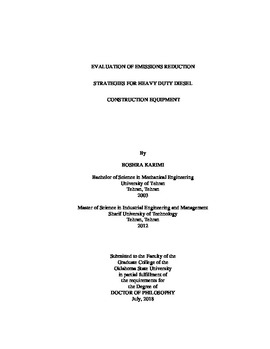| dc.contributor.advisor | Shan, Yongwei | |
| dc.contributor.author | Karimi, Boshra | |
| dc.date.accessioned | 2019-03-20T19:25:35Z | |
| dc.date.available | 2019-03-20T19:25:35Z | |
| dc.date.issued | 2018-07 | |
| dc.identifier.uri | https://hdl.handle.net/11244/317635 | |
| dc.description.abstract | Heavy-duty diesel (HDD) construction equipment expends a considerable amount of fuels and correspondingly emits a substantial amount of pollutants to the air. This dissertation assesses potential impacts of diesel exhaust on operator and investigates some emission reduction strategies for HDD construction equipment based on real-world in-use data. Second-by-second data for fuel use and emission rates of hydrocarbons (HC), carbon monoxide (CO), carbon dioxide (CO2), nitrogen oxides (NOx), and particular matter (PM) as well as engine attributes were collected from 32 HDD construction equipment using Portable Emission Measurement Systems (PEMS). | |
| dc.description.abstract | First, the impacts of tailpipe diesel exhaust emissions on Indoor Air Quality(IAQ) in heavy equipment cabs were characterized. The working hypothesis for this objective was tailpipe pollutant concentrations of NOx, CO, CO2, and PM exceed industry Permissible Exposure Limit (PELs). Based on the results, tailpipe emissions of NOx, CO, and CO2 greatly exceed their respective PEL (or reasonable surrogate). In some cases, the limit was exceeded by orders of magnitude. | |
| dc.description.abstract | Therefore, some emission reduction strategies were investigated to improve IAQ in heavy equipment cabs. Using the same real world data, statistical comparisons of B20 versus petroleum diesel fuel use were performed on a fleet of backhoes, motor graders, and wheel loaders. Results show that B20 had a non-significant higher average price per gallon, as well as a significantly higher average hourly fuel use rate than petroleum diesel; however, B20 had significantly lower average emissions of NOx, HC, CO, and CO2 on a gram per gallon basis. | |
| dc.description.abstract | Then, the energy and environmental impact of engine tier standards (tier 0 vs. tier 1 vs. tier2) were assessed. Based on the results, the major conclusion is that there are measurable differences in the impacts of higher tier number when used in off-road maintenance equipment. Overall, we can see an improvement in emission rates in more than 60% of cases, when higher tier number was concerned. Fuel use decreases as well in almost all cases with higher tier number. So, the general conclusion is that higher tier number has a positive environmental impact based on reductions in emissions of NOx, HC, CO, and CO2 on a grams per gallon and gram per hour basis as well as fuel use on a gram per hour basis. | |
| dc.format | application/pdf | |
| dc.language | en_US | |
| dc.rights | Copyright is held by the author who has granted the Oklahoma State University Library the non-exclusive right to share this material in its institutional repository. Contact Digital Library Services at lib-dls@okstate.edu or 405-744-9161 for the permission policy on the use, reproduction or distribution of this material. | |
| dc.title | Evaluation of emissions reduction strategies for heavy duty diesel construction equipment | |
| dc.contributor.committeeMember | Veenstra, John N. | |
| dc.contributor.committeeMember | Lewis, Phil | |
| dc.contributor.committeeMember | Liang, Ye | |
| osu.filename | Karimi_okstate_0664D_15864.pdf | |
| osu.accesstype | Open Access | |
| dc.type.genre | Dissertation | |
| dc.type.material | Text | |
| thesis.degree.discipline | Civil Engineering | |
| thesis.degree.grantor | Oklahoma State University | |
